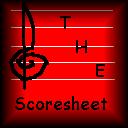AIR
FORCE
ONE
by, you guessed it, Jerry Goldsmith
This is an example of a typical '90s Goldsmith action score. While
not particularly memorable, it provides some great excitement and bombast.
Unfortunately, like a lot of other Varese releases, this truncates the
score (35 minutes), omitting several great tracks, including a massive
Russian choral piece. In the movie, Joel McNeely was brought in to
assist Goldsmith with the monumental task of writing a replacement score
for Randy Newman in two weeks. Of course, Varese Sarabande omits
all of these sections, but what they do give us is very good.
Track by Track Analysis
1. The Parachutes (5:14)
In this opening cue, Goldsmith introduces his major Presidential theme,
slightly reminiscent of his earlier First Contact theme. After a
horn fanfare, he gives us our first hearing of the patriotic theme.
While it's very noble and uplifting, it's a little over the top, to the
point of being corny. After the main titles, he does a minute of
ambiance with snare drums, and then gives us the first hint of the terrorist
motif. This leads into his first major action cue, blending a minor
key permutation of the opening horn fanfare with snare drums. The
cue ends with a moving string melody accompanied by chimes.
2. The Motorcade (2:40)
This begins with the horn fanfare from the main title, which the cue
puts through several permutations. The rest of the track is a stirring
statement of the main theme.
3. Empty Rooms (4:02)
The second major action cue opens with low suspense building music,
followed by an outburst of the minor key horn motif. Parts have a
driving piano motif under a chopping string ostinato. Eventually
he adds a new melody over the piano, which quiets into more tension.
4. The Hijacking (7:30)
This is the principal action set piece, the one I always listen to.
It opens with the terrorist motif heard in track one, which then gets a
full statement under a string ostinato. As if to contrast the two
opposing parties, he plays the terrorist motif with the string ostinato
and the Presidential horn motif in succession a few times, with the snare
drum beating constantly. Next we get a desperate running action motif
based on the horn fanfare. One of the bridges between the two themes
is a great chromatic trumpet section. Eventually he combines the
two main themes complete with snare drum, etc. In the final minute,
he climaxes the track with a motif based on a sixth interval. Like
I said above, this track is basically variations on both main themes playing
against each other, which makes for great listening.
5. No Security (2:59)
We finally get a respite from the breakneck action with this tender
cue, introducing a motif on the oboe with string accompaniment. After
this, Goldsmith gives us a moving rendition of his main theme, followed
by another statement of the opening motif.
6. Free Flight (4:41)
More of the opening horn fanfare, with various percussion and orchestra
meanderings, which lead into an abrupt entrance of the terrorist motif
and one of the action ostinatos from track 4. In one part, he combines
the snare drum with the tender motif from the previous track, and eventually
gives us another statement of the main theme. This abruptly ends
with the onset of more action music, more frenzied and with no thematic
connection.
7. Escape From Air Force One (5:25)
This is the last major action cue of the album,
with more snare drum and horn fanfare. The music is becoming wearing
by now, however, and all begins to sound the same. A tender interlude
features the return of the main theme, which is cut off by more action
music. It becomes very complex, with a great string run, and the
track climaxes with pounding chords.
8. Welcome Aboard, Sir (2:06)
After a quiet prelude, the snare drum motif returns,
which leads back into the first motif, and the themes play in succession
a few times. He gives us one last listen to the spacious main theme,
and the album ends.
Overall this is another solid Goldsmith effort,
not especially memorable, but the theme is nice, and the action cues are
all done in his typical competent fashion. If you want a good example
of his current style of film scoring, I suggest you buy this.
Air Force One: The Final Score
| Music Rating |
7/10 |
|
|
| Packaging/Liner Notes |
N/A |
| Orchestral Performance |
9/10 |
| Sound Quality |
9/10 |
| Length |
3/10 |

| Reviews
by Title | Reviews
by Composer | Links
Page | ScoreSheet
Home |
Air Force One is Copyright 1997 by Varese Sarabande. Its appearance
on this site is for informational purposes. Review Copyright 1999
by Andrew Drannon. That's right, these opinions aren't those of Tripod.